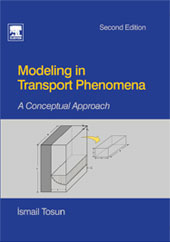Modeling in Transport Phenomena - A Conceptual Approach

Second Edition |
Modeling in Transport Phenomena presents and clearly explains through appropriate example problems the basic concepts and their applications to fluid flow, heat transfer, mass transfer, chemical reaction engineering, and thermodynamics. A balanced approach between analysis and synthesis is presented throughout. Systematic derivations of the equations as well as the physical significance of each term are given in detail so that students to easily understand and follow up the presented material.
There is a strong incentive in science and engineering to understand why a phenomenon behaves the way it does. For this purpose, a complicated real-life problem is transformed into a mathematically tractable problem while preserving the essential features of it. Such a process, known as mathematical modeling, requires understanding of the basic concepts. This book teaches students these basic concepts and shows the similarities between them. Answers to all problems are provided allowing students to check their solutions. Emphasis is on how to get the model equation representing a physical phenomenon and not on exploiting various numerical techniques to solve mathematical equations.
Key Features
- A balanced approach is presented between analysis and synthesis; students will understand how to use the solution in engineering analysis
- Systematic derivations of the equations as well as the physical significance of each term are given in detail
- Many more problems and examples are given than in the first edition - answers provided
|
|
Review from Barnes & Noble
"This is a book in an area that beginning students in chemical engineering find it difficult to grasp. Several books on this subject, with varying titles, have appeared over the years. They are helpful in fully understanding the established text "Transport Phenomena" by Bird, Stewart, and Lightfoot (BSL). With the publication of the second edition of that book, Tosun's book on basic concepts becomes even more useful. While it stands on its own merits in the breadth, quality, and scope of the subject, it can also be a very useful adjunct to more advanced texts that assume a certain level of basic understanding. Of the many books on basic concepts that I have seen, Tosun's book is perhaps the best written. The concepts are explained with the utmost clarity in simple and elegant language. It is eminently readable."
Institutions Using the Book
Required Textbook
- University of Mississippi - Transport Phenomena (Engr 322)
- University of South Alabama - Advanced Chemical Models (551/490)
- University of Waterloo - Micro and Nanosystem Computer-aided Design (NE 336)
- Indian Institute of Technology (Kanpur) - Transport Phenomena
- Curtin University (Sarawak) - Transport Phenomena (ChE 323)
- Universidad Nacional Autonoma de Mexico - Fenomenos de Transporte
- Izmir Institute of Technology - Mathematical Modeling in Engineering (ChE 330)
- Trakya University - Mathematical Applications in Food Engineering (GM 411)
Recommended Textbook
- University of Texas at Austin - Transport Phenomena (ChE 353)
- Swiss Universities of Applied Sciences - Heat and Mass Transfer With Two Phase Flow
- Universidad de Alicante - Transport Phenomena (7388)
- Escola Universitària d'Enginyeria Tècnica Industrial de Terrassa - Processos de Transferència de Massa
i Calor (28665)
- Universidad de Valladolid - Fenomenos de Transporte
- Universidade de Santiago de Compostela - Fenomenos de Transporte (201524)
- The University of Punjab - Advanced Transport Phenomena (ChE 620)
- Gazi University - Transport Phenomena (KM 511)
- Selçuk University - Mathematical Modeling in Chemical Engineering
- University of Engineering & Technology, Lahore - Transport Phenomena
- Jawaharlal Nehru Technological University Kakinada- Transport Phenomena
